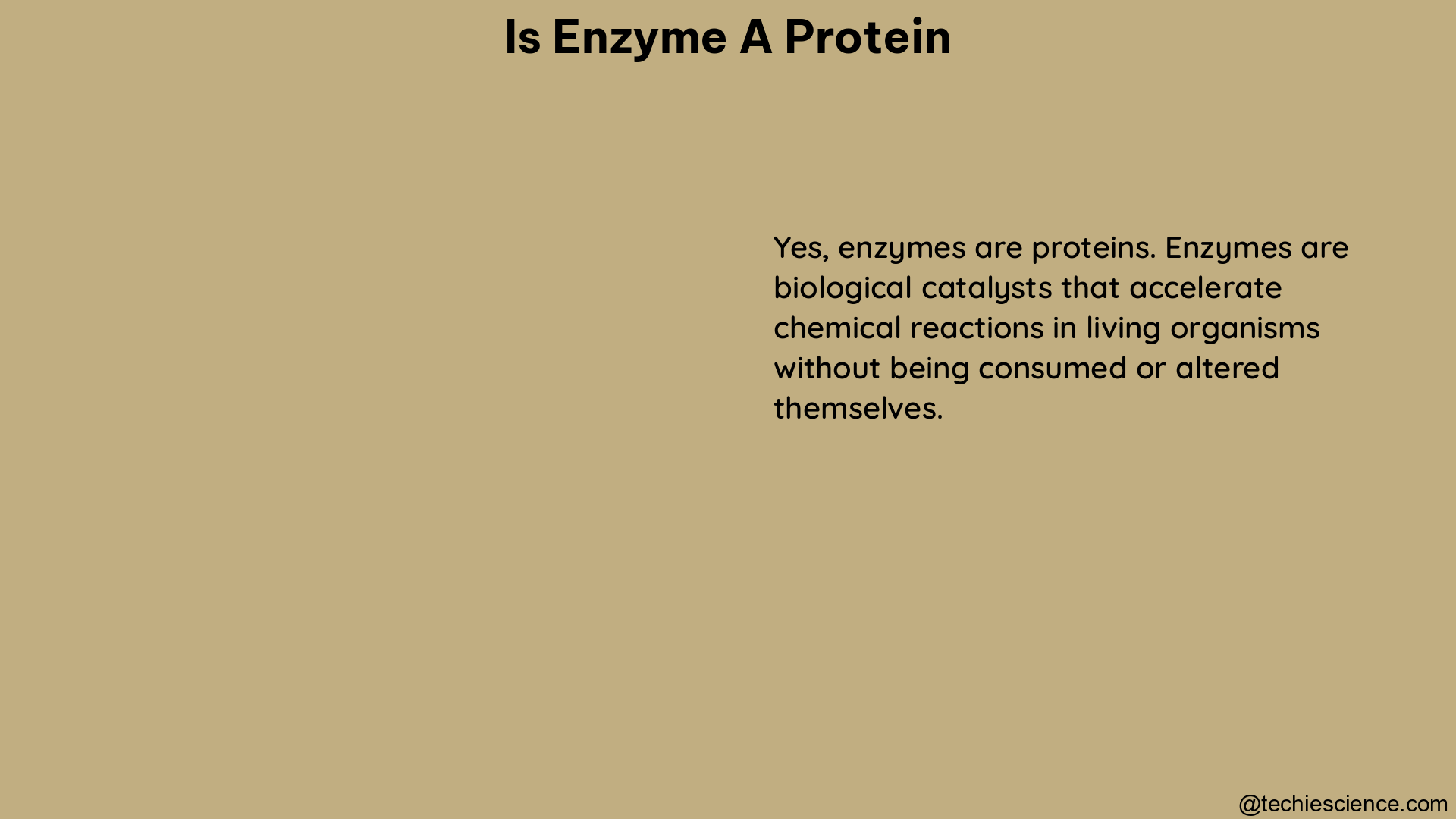Enzymes are a class of proteins that play a crucial role in facilitating and accelerating chemical reactions within living organisms. These remarkable biomolecules are responsible for catalyzing a wide range of essential processes, from digestion and metabolism to cellular signaling and gene expression. Understanding the intricate relationship between enzymes and proteins is fundamental to unraveling the complex mechanisms that sustain life.
The Protein Nature of Enzymes
Enzymes are indeed proteins, and this fact is supported by a wealth of measurable and quantifiable data. Proteins are large, complex molecules composed of long chains of amino acids, and enzymes are a specialized subset of these biomolecules that possess the unique ability to catalyze chemical reactions.
Amino Acid Sequence Comparison
One of the primary ways to confirm the protein nature of enzymes is by determining their amino acid sequence and comparing it to the predicted sequence for a given enzyme. This can be done experimentally using techniques such as Edman degradation or mass spectrometry. By comparing the observed amino acid sequence to the expected sequence for a known enzyme, researchers can provide direct evidence that the enzyme is indeed a protein.
Specific Activity Measurements
Enzymes are characterized by their specific activity, which is defined as the enzymatic activity (measured in defined units) per unit mass of protein (typically milligrams of protein). This specific activity is a quantifiable parameter that can be used to confirm the identity and purity of an enzyme preparation. By measuring the specific activity of an enzyme, researchers can ensure that the observed catalytic properties are attributable to the protein of interest and not to any contaminants.
Enzyme Assays and Activity Measurements

Enzyme assays are a crucial tool for identifying and quantifying the activity of specific enzymes. These assays are performed for a variety of purposes, including the characterization of enzyme kinetics, the development of enzyme-based diagnostic tests, and the screening of potential enzyme inhibitors or activators.
Measuring Enzyme Activity
Enzyme activity is typically measured in units per milliliter (units/mL), and this value is a key parameter when designing and optimizing enzyme assays. The activity value determines the amount of substrate that is converted into product, and it is essential to operate within a linear range when measuring enzyme activity.
Ensuring Linearity in Enzyme Assays
To ensure accurate enzyme activity measurements, it is crucial to operate in a linear range, where the assay signal (e.g., absorbance, fluorescence, or luminescence) is directly proportional to the enzyme concentration. This means that a plot of the assay signal versus the enzyme concentration should be linear, and the degree of substrate conversion should be less than 15%. By carefully controlling the assay time, temperature, and the number of enzyme units added, researchers can maintain the reaction within the linear range and obtain reliable enzyme activity data.
Structural and Functional Characteristics of Enzymes
Enzymes possess unique structural and functional characteristics that distinguish them from other types of proteins. These features are essential for their catalytic abilities and the regulation of their activity.
Enzyme Structure and Active Site
Enzymes typically have a complex three-dimensional structure, often with multiple subunits or domains. At the heart of an enzyme’s structure is the active site, a specialized region where the substrate binds and the catalytic reaction takes place. The precise arrangement of amino acids within the active site is crucial for the enzyme’s catalytic efficiency and specificity.
Enzyme Kinetics and Regulation
Enzymes exhibit characteristic kinetic properties, such as the Michaelis-Menten constant (Km) and the maximum velocity (Vmax), which describe the enzyme’s affinity for its substrate and the rate of product formation, respectively. These kinetic parameters can be determined experimentally and used to understand the enzyme’s catalytic mechanism and its response to various regulatory factors, such as inhibitors, activators, or allosteric modulators.
Enzyme Specificity and Catalytic Efficiency
Enzymes are highly specific, capable of recognizing and binding to their target substrates with remarkable precision. This specificity is achieved through the unique structural features of the enzyme’s active site, which are complementary to the substrate’s shape and chemical properties. Additionally, enzymes are known for their remarkable catalytic efficiency, often capable of accelerating chemical reactions by several orders of magnitude compared to the uncatalyzed reactions.
Conclusion
In summary, enzymes are indeed proteins, and this fact is supported by a wealth of measurable and quantifiable data. From the determination of amino acid sequences to the precise measurement of specific activity, the protein nature of enzymes is well-established. Enzyme assays play a crucial role in identifying and quantifying enzyme activity, and it is essential to operate within a linear range to ensure accurate results. The unique structural and functional characteristics of enzymes, such as their active site, kinetic properties, and catalytic efficiency, further reinforce their identity as specialized proteins that are essential for the proper functioning of living organisms.
References:
- Quizlet. (n.d.). BIOL 1011 Midterm. Retrieved from https://quizlet.com/780691147/biol-1011-midterm-flash-cards/
- Quizlet. (n.d.). Biochem Lab. Retrieved from https://quizlet.com/572025650/biochem-lab-flash-cards/
- Biomol. (2021). Guide to Enzyme Unit Definitions and Assay Design. Retrieved from https://www.biomol.com/resources/biomol-blog/guide-to-enzyme-unit-definitions-and-assay-design
- Segel, I. H. (1975). Enzyme Kinetics: Behavior and Analysis of Rapid Equilibrium and Steady-State Enzyme Systems. Wiley-Interscience.
- Nelson, D. L., & Cox, M. M. (2017). Lehninger Principles of Biochemistry (7th ed.). W.H. Freeman.

Hello, I am Bhairavi Rathod, I have completed my Master’s in Biotechnology and qualified ICAR NET 2021 in Agricultural Biotechnology. My area of specialization is Integrated Biotechnology. I have the experience to teach and write very complex things in a simple way for learners.